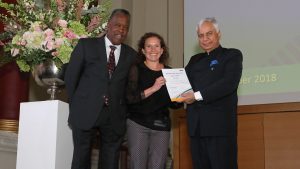It’s so easy to get caught up in all the small and complicated stuff when you’re trying to improve how you feel during the menopause. Calculating protein intake, looking at heart rate zones and tweaking running plans for example. These measures can all be helpful but it’s vital not to underestimate the power of one simple thing you can do every day. Something that doesn’t require any maths, special skill or monitoring. What is it? Stand up. Yep, that’s it. Stand up.
The average amount of time an adult spends sitting each day in the UK is 9.5 hours! How about you?
Let me explain why standing is so important, the benefits you’ll get and how easy it is to fit it into what you’re already doing.
The power of movement
Quite simply, our bodies were designed to move. We have super little power packs in our cells which constantly create energy, these are called mitochondria. If we spend a lot of time sitting and don’t use the energy the mitochondria are making, then the cells can become damaged and die early. Early cell death causes inflammation in our body and we know that this type of inflammation causes and speeds up major medical conditions such as heart disease, cancer and type 2 diabetes. Simply by getting up and moving around for a couple of minutes every half an hour, we will stop that energy build up in the cell, prevent early cell death and reduce inflammation. Powerful stuff eh?! But there’s more…
This goes deep
Something else that causes inflammation in the body is visceral fat. This is the harmful fat that sits in and around our major organs such as our heart, liver and muscles. People who have higher visceral fat levels have a significantly increased risk of these major diseases. When we sit for prolonged periods of time we are more likely to store excess energy as fat. Certain ‘fat burning’ enzymes switch off after around 20 minutes of sitting. Simply by getting up and moving around for a couple of minutes every half an hour, we will stop our body switching into fat storage mode, reduce our visceral fat and reduce inflammation.
Our body’s own medications
There’s actually even more to tell you! When we move around and use our muscles, they produce myokines. Myokines zoom around in our circulation and act as anti-inflammatories. They can help reduce that long term inflammation in our body which in turn helps to reduce our risk of many major medical conditions. Simply by getting up and moving around for a couple of minutes every half an hour we will trigger myokine release, reduce inflammation and help to lower our risk of disease.
Why running isn’t enough
As a runner, you may not think that you need to worry about this. You’re doing a 5k after work today and did a long run at the weekend, surely that’s plenty of movement? Sorry to break it to you but the running doesn’t cancel out the sitting. It does count towards the 150 minutes of moderate intensity exercise that is recommended for good health BUT there’s another part to those recommendations and that is to reduce sedentary time. There are risks associated with sitting that are independent of that aerobic activity, particularly the risk of type 2 diabetes. We have to do both, running and moving frequently throughout the day.
Movement and menopause
One of the biggest complaints during perimenopause and post menopause is the change that women see in their body composition. Fat storage commonly increases, especially around the middle of the body and may women see their waists expanding. Some of this will be subcutaneous fat (just under the surface of the skin) but there is a propensity to store extra visceral fat too. There are various reasons and theories to explain this but I think one thing we all need to look at is our lifestyle. Are we sitting more than we used to? Think about how your daily life looks now compared to how it did ten years ago. A lot of this depends on your job but also think about what you do in your spare time, with friends and family. Are you sitting more? Remember too that you are losing muscle mass which potentially means fewer anti-inflammatory myokines. Muscles waste even more if they aren’t used. The simple action of moving more throughout the day can make a huge difference to our health now and in the future.
It all adds up
If you know me or have heard me speak, you will know how keen I am on small habits, achievable things that don’t take a lot of effort but can have huge impact if done over and over again. And reducing sedentary time is a perfect example of how this can work.
What things do you already do in your daily life that you could do standing up?
- Making a telephone call
- Texting
- Scrolling social media
- Being in online meetings
- Being at in-person meetings
- Having coffee with a friend
- Inputting data
- Searching for holidays
- On public transport
- Watching the ad breaks
Pretty much anything! Even deep work where you really have to concentrate can be done standing, it takes a bit of practice at first but it’s possible.
You don’t need a fancy desk that goes up and down (great if you can access one though!). You can buy cheap stands you put on top of your current desk or standing work stations. I work on a window sill with my laptop on a pile of place mats or a couple of big books! It’s not glamorous but the angles are just right for me to feel comfortable.
It takes time and practice but standing more can so easily become part of your every day. Try setting a reminder on your phone, desktop or sports watch. You need a prompt, especially in the early days. I would advise starting with short blocks of standing work and gradually building up. I went straight into a standing eight hour work day and it was too much too soon. My back and hamstrings hurt.
Standing posture tips
It’s really important to make sure you have good posture when you’re standing. Wear comfortable, flat shoes or be barefoot. Put your shoulders back and head up. Stand tall and keep your weight evenly spread between your feet, avoid sinking into one hip.
It’s best not to keep completely still. Walk on the spot a bit, sway, do hip circles. You can even do some upper body exercises and the occasional squat, lunge or one leg balance if you’re keen. It’s so much easier to just be a bit more active than if you were sitting down.
Sometimes you just want to sit
Of course we all like and need a sit down sometimes and I’m not suggesting that just crashing out on the sofa for a few hours should never happen. This is about looking at our day to day lives and what we do most of the time. Small changes to that are easy to do. They may not feel like much at the time but they add up. If you work for just one hour a day standing for five days a week, for one year, that’s 260 hours on your feet. That’s a very long time and will undoubtedly make a difference to your future health.
I’m writing this standing up. Choose one thing today that you can do standing up too. Your eighty year old self will thank you.
If you’ve enjoyed this blog you can get more tips and tricks from me every week by signing up for my newsletter below. I also have a free Runner’s Guide to Perimenopausal Weight Control which you can download here.
Image by beauty_of_nature from Pixabay







